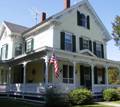
Folk Victorian (1870s – 1910s)
Plain folk could afford these simple North American homes.
History:
Life was simple before the age of railroads. In the vast, remote stretches of North America, families built no-fuss, square or L-shaped houses in the National or Folk style. But the rise of industrialization made it easier and more affordable to add decorative details to otherwise simple homes. Decorative architectural trim could be mass produced. As the railroads expanded, factory-made building parts could be sent to far corners of the continent.
Many Folk Victorian houses were adorned with flat, jigsaw cut trim in a variety of patterns. Others had spindles, gingerbread and details borrowed from the Carpenter Gothic style. With their spindles and porches, some Folk Victorian homes may suggest Queen Anne architecture. But unlike Queen Anne’s, Folk Victorian houses are orderly and symmetrical houses. They do not have towers, bay windows, or elaborate moldings.
Features:
Square, symmetrical shape
Brackets under the eaves
Porches with spindlework or flat, jigsaw cut trim
Some Folk Victorian homes have:
Carpenter Gothic details
Low-pitched, pyramid shaped roof
Front gable and side wings
Next: Queen Anne